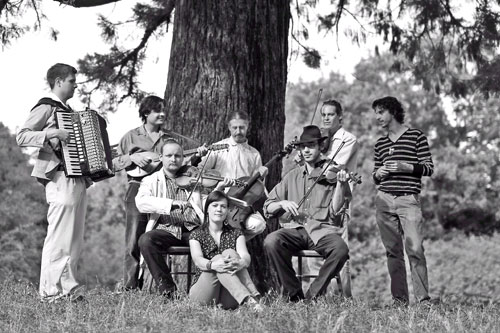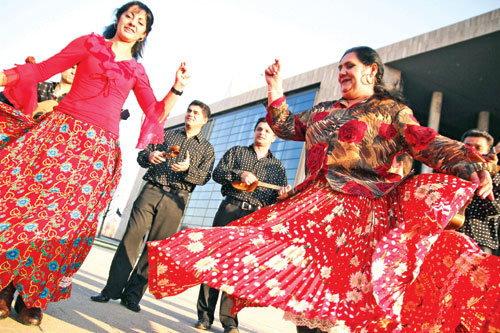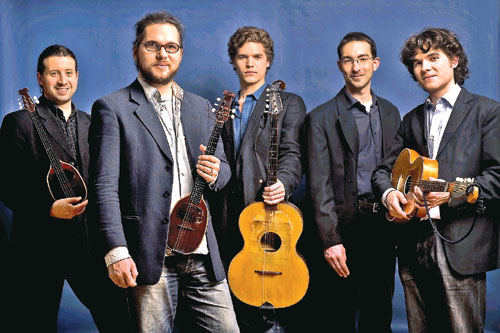
 |
|
The Buda Folk band was founded in 2007 by a group of young city dwellers, whose parents and teachers instigated the Dance House Movement of Hungary in the 1970s. |
 |
|
Parno Graszt ("White Horse"), from the village of Paszab, has made its name known internationally as an authentic Hungarian Gypsy music ensemble. |
 |
|
Founded by Hungarian Serb musicians, Sondorgo tries to foster and preserve Southern Slavic music traditions, as found in various settlements in Hungary. |
Related: No world music without folk music
Hungary's Dance House Movement is recognized by UNESCO as an intangible cultural heritage. It impressed Mu Qian, in Budapest, who was there to visit a festival, and prompted him to reflect on China's musical traditions.
It is a typical Friday night at the Fono music club in Budapest. A traditional band plays with violin, koboz (lute) and flute, as hundreds of young Hungarians dance the evening away to quick beats, whirling and perspiring. "Hungarian people keep their traditional folk music and dance well," says Laszlo Horvath, director of Fono club. "Although many young people like to dance to electronic music, as elsewhere in the world, there are also many who really enjoy this kind of dance house."
Tanchaz, which literally means "dance house" in Hungarian, is a casual folk dance event that has been popular in Hungarian cities since the 1970s.
Tanchaz draws on traditional folk music and dance from across Hungary and Transylvania (a region of Romania), and was recognized by UNESCO as an intangible cultural heritage in 2011.
"The Dance House Movement played an important role in the acceptance of village folk music in the urban environment," says Soma Salamon, a 22-year-old musician with the Fanfara Complexa band, which plays at many dance houses in Budapest.
"It's very important that our parents' generation learned folk music in the '70s and '80s. We learned from them, and now we can make our music."
Using a variety of traditional instruments, like the shepherd's flute, Jew's harp and bagpipes, Fanfara Complexa plays folk music from the Carpathian basin, which is centered in Hungary but also encompasses parts of Serbia, Slovakia and Romania. Some of their works also have Balkan influences.
"My generation is more open, and we adopt different elements in our music, but it's not possible without knowledge of the authentic styles," Salamon says.
Fanfara Complexa and Buda Folk, another band that Salamon plays in, were both featured at From the Rill to the Ocean: Hungarian Folk and World Music Flow, a recent showcase festival in Budapest that presented 23 Hungarian acts.
Among them were not only traditional musicians but also bands like psychedelic rock group Fokatelep, Gypsy folk band Parno Graszt, DJ Suefo and the Dresch jazz quartet. All fuse roots music into their language.
Miklos Both, guitarist with Napra and FolkSide - two groups that performed at the festival - says he's more interested in learning traditional music and then creating something new. He went to the countryside to study fiddle, but after that he tried to infuse fiddle techniques into his electric guitar playing.
"Bela Bartok did the same thing. He collected a lot of Hungarian folk music, but he made new music inspired by what he got from traditional music," says Both, 29. "That is a good direction."
Both also draws inspiration from other countries' music. In 2011, he traveled in China for a month, and the experience led to Star Nest, his composition with FolkSide.
"When I was in a Chinese village, I heard a musician play the erhu (two-stringed fiddle). It was so beautiful and interesting for me, especially the crescendo," he says.
"After I came back, I sat down and played the guitar with this erhu crescendo feeling, and then I had this song."
The blending of traditional and modern elements into a "world music" started in Hungary in the early 1980s, pioneered by such bands as Muzsikas, Kolinda and Makam.
"They were the first ones to create something new on the base of traditional Hungarian folk music," says Csaba Lokos, mastermind of From the Rill to the Ocean. "Now, there are a lot more bands with traditional elements."
Lokos, 54, started working in the domain of Hungarian folk and world music in the 1980s, with a state-run company. Now he has his own agency, CL Music, which represents several established Hungarian bands like Napra, Parno Graszt and Csik.
Lokos recalls that in the early 1990s, when Hungarian bands began to be exposed internationally after the political system changed, Hungarian music became exotic and trendy around the world, and bands like Muzsikas and Ando Drom toured successfully the globe.
Compared to the past, Hungarian musicians can travel abroad much more freely. But they have to compete with musicians from all over the world now, Lokos notes.
As new trends like Balkan brass Gypsy music and Latin electronica have emerged in the world music market, the enthusiasm for Hungarian music has declined in recent years.
That's why Lokos initiated From the Rill to the Ocean. Together with some music venues in Budapest like the A38, Akvarium Klub, Palace of Arts and Hungarian Heritage House, Lokos selected 22 acts that represent the Hungarian folk and world music scene to perform at the festival.
"We want to showcase a variety of Hungarian music through the event, from traditional folk to crossover but all with roots elements," he says.
Lokos invited a group of music professionals from all over the world to attend the festival, hoping to promote Hungarian music more widely. And he plans to organize the event annually.
"I'm quite sure we have a reserve for the next 10 years. This area of Hungarian music is very colorful and rich," he says.
"Hungarian music may not sound so exotic today, but we are still here."